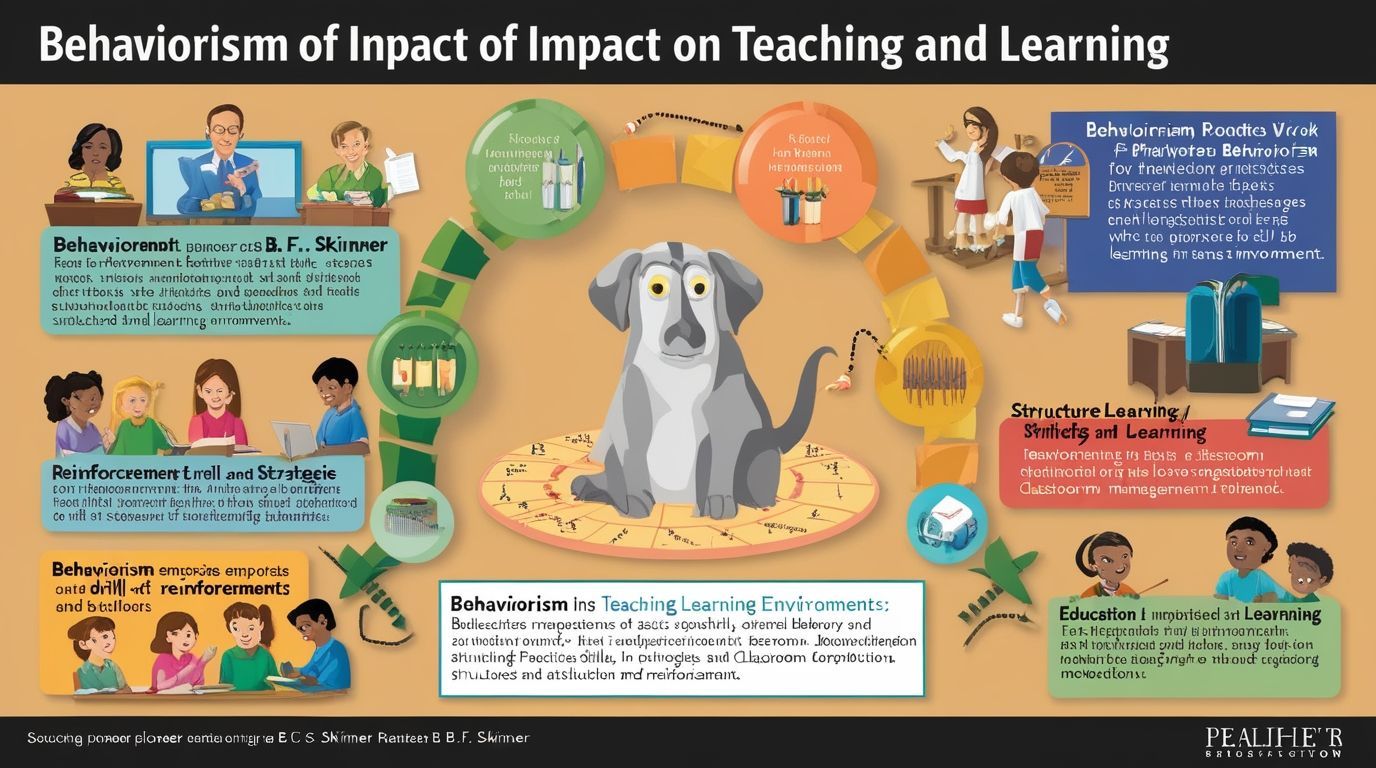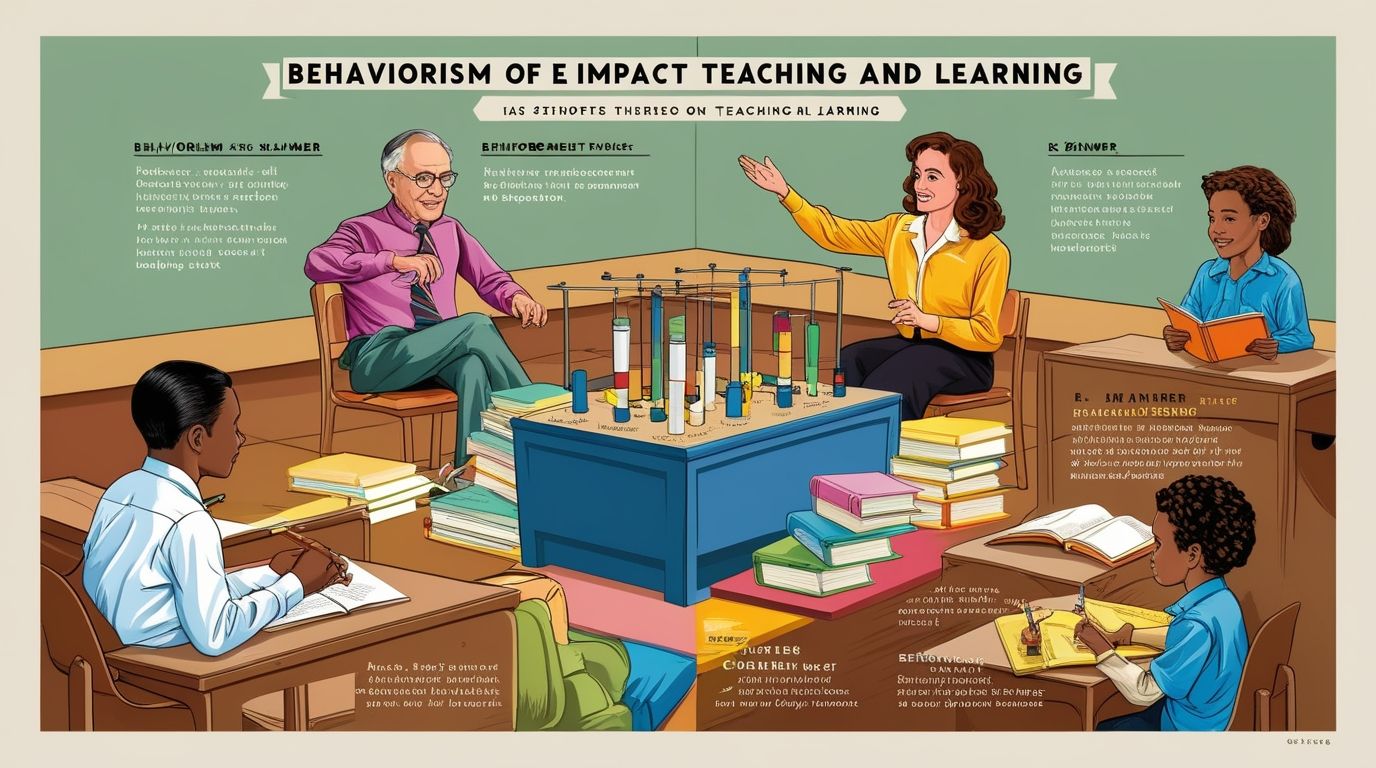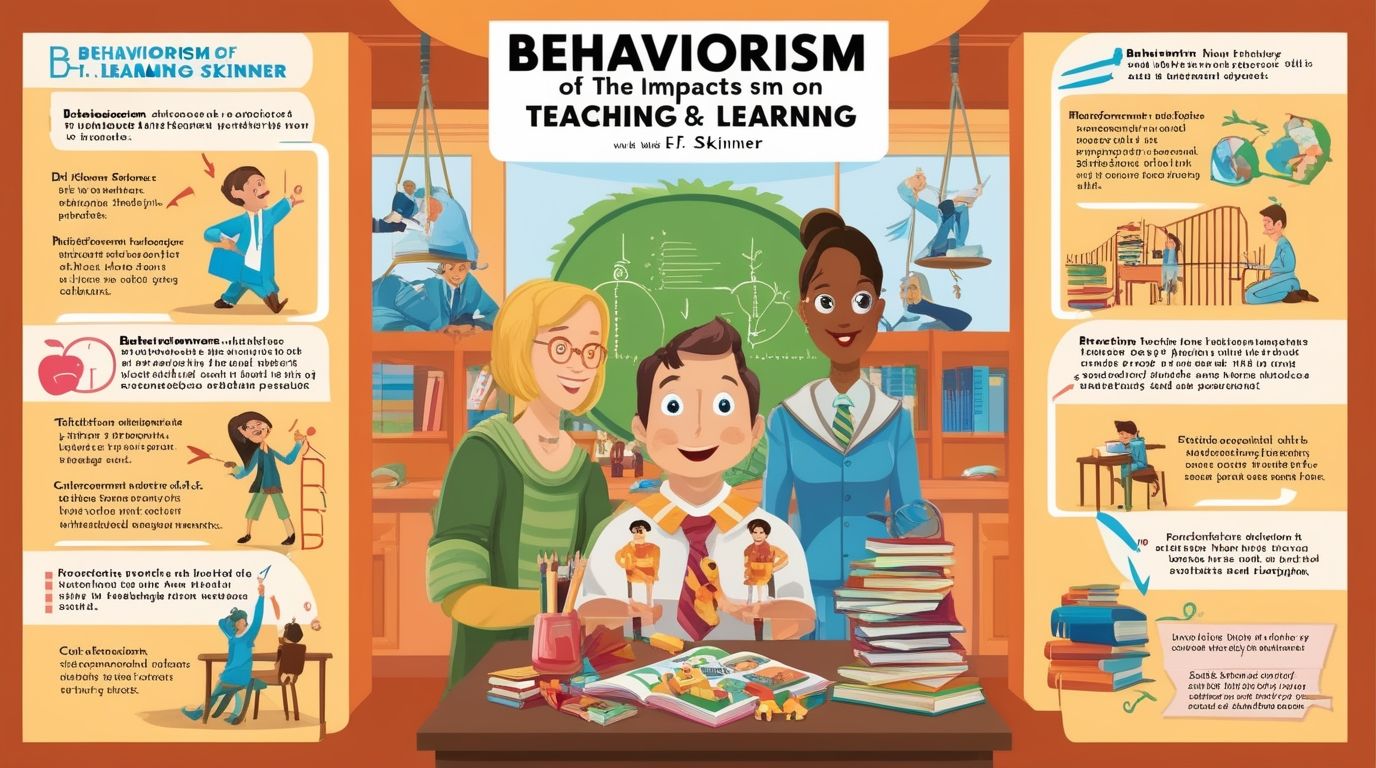The Impact of Behaviorism on Teaching and Learning Behaviorism, a foundational theory in psychology, has significantly influenced teaching and learning practices. Rooted in the work of pioneers like John B. Watson and B.F. Skinner, behaviorism emphasizes the role of environmental stimuli in shaping behavior. This theory posits that learning a result of associations formed between stimuli and responses, which can observed, measured, and modified. In education, behaviorism has provided a systematic approach to understanding how students learn and how teachers can enhance learning outcomes. This article explores the key principles of behaviorism and its impact on teaching and learning, discussing both its benefits and limitations.
Key Principles of Behaviorism
Behaviorism is grounded in several key principles that have shaped its application in education:
- Stimulus-Response (S-R) Relationships: Behaviorism is based on the idea that learning occurs through the formation of associations between stimuli (environmental factors) and responses (observable behaviors). This S-R relationship central to understanding how behavior learned and modified.
- Reinforcement and Punishment: Reinforcement a core concept in behaviorism, where behaviors strengthened by positive reinforcement (rewards) or negative reinforcement (removal of aversive stimuli). Conversely, punishment weakens undesirable behaviors by introducing negative consequences or removing positive stimuli.
- Conditioning: Conditioning, both classical (Pavlovian) and operant (Skinnerian), plays a crucial role in behaviorism. Classical conditioning involves associating a neutral stimulus with an unconditioned stimulus to elicit a conditioned response. Operant conditioning focuses on how behaviors shaped by consequences, with reinforcement and punishment serving as key mechanisms.
- Observable Behavior: Behaviorism emphasizes the importance of observable and measurable behavior. Unlike cognitive theories that delve into mental processes, behaviorism focuses on outward behaviors that can be objectively studied and modified.

Impact of Behaviorism on Teaching
Behaviorism has significantly influenced teaching practices, leading to the development of instructional strategies that are still widely used today. Some of the key impacts include:
- Structured Learning Environments: Behaviorism advocates for structured learning environments where clear expectations, rules, and routines are established. This structure helps in managing classroom behavior and creating an atmosphere conducive to learning. Teachers use reinforcement techniques to encourage positive behaviors and minimize disruptions.
- Reinforcement Strategies: In line with behaviorist principles, teachers employ various reinforcement strategies to promote desired behaviors. Positive reinforcement, such as praise, rewards, and privileges, is commonly used to motivate students. For example, a teacher might give a student a sticker or verbal praise for completing their homework on time, reinforcing the behavior of timely submission.
- Drill and Practice: Behaviorism has contributed to the development of drill-and-practice methods, particularly in subjects like mathematics and language learning. These methods involve repeated practice of specific skills or content until mastery achieved. The repetitive nature of these exercises designed to reinforce correct responses and ensure retention.
- Behavioral Objectives: The behaviorist approach to education emphasizes the use of clear, measurable behavioral objectives. Teachers design lessons with specific outcomes in mind, focusing on what students should be able to do after instruction. This focus on observable outcomes ensures that learning can be assessed and modified as needed.
- Direct Instruction: Direct instruction, a teaching method closely aligned with behaviorism, involves explicit teaching of skills and knowledge through teacher-led activities. This approach characterized by clear instructions, modeling, guided practice, and immediate feedback. It is particularly effective in teaching basic skills and factual knowledge.
- Classroom Management: Behaviorism has also played a crucial role in shaping classroom management techniques. Teachers use behaviorist strategies, such as behavior contracts, token economies, and time-out procedures, to manage student behavior and maintain an orderly learning environment. These strategies are designed to reinforce positive behaviors and reduce disruptive ones.
Impact of Behaviorism on Learning
Behaviorism’s influence extends beyond teaching practices to how students learn and interact with instructional materials. Its impact on learning includes:
- Active Learning: Behaviorism encourages active learning, where students actively engaged in the learning process through participation and practice. The emphasis on reinforcement ensures that students receive immediate feedback, which helps in reinforcing correct responses and correcting mistakes.
- Mastery Learning: The behaviorist approach to learning promotes the idea of mastery learning, where students expected to achieve a high level of proficiency in specific skills before moving on to more complex tasks. This approach ensures that foundational skills firmly established, reducing the likelihood of learning gaps.
- Behavior Modification: Behaviorism has provided the foundation for behavior modification techniques used to address learning challenges. Students with behavioral or learning difficulties can benefit from structured interventions that use reinforcement and punishment to shape desired behaviors. For example, a student struggling with attention issues might be given a reward system to encourage on-task behavior.
- Skill Acquisition: Behaviorism is particularly effective in the acquisition of basic skills and rote learning. Through repetition and reinforcement, students can develop automaticity in skills such as reading, writing, and arithmetic. This foundation allows students to build more complex cognitive skills over time.
- Personalized Learning: Although behaviorism often associated with standardized approaches, it has also contributed to personalized learning strategies. Teachers can use data from assessments and observations to tailor reinforcement techniques to individual students’ needs, providing targeted support that enhances learning outcomes.

Criticisms and Limitations of Behaviorism
Despite its significant impact on education, behaviorism has faced criticism and has limitations that educators must consider:
- Overemphasis on Observable Behavior: One of the primary criticisms of behaviorism is its focus on observable behavior at the expense of cognitive processes. Critics argue that behaviorism neglects the importance of internal mental states, such as motivation, emotions, and thinking, which are crucial for understanding complex learning processes.
- Limited Scope: Behaviorism is most effective in teaching basic skills and behaviors, but it may not be sufficient for fostering higher-order thinking skills, creativity, and problem-solving. These cognitive processes require a more holistic approach that considers the interplay between behavior, cognition, and emotions.
- Extrinsic Motivation: The reliance on external reinforcement, such as rewards and punishments, can lead to extrinsic motivation, where students engage in learning activities primarily for the sake of rewards. This can undermine intrinsic motivation, which driven by curiosity, interest, and a desire for mastery.
- Ethical Concerns: Some behaviorist techniques, particularly those involving punishment, raise ethical concerns. Critics argue that punishment can lead to negative emotional outcomes and may not be effective in promoting long-term behavior change. Educators must use behaviorist strategies responsibly and ethically.
- Lack of Student Agency: Behaviorism’s teacher-centered approach can limit student agency and autonomy. In behaviorist classrooms, students may have little opportunity to take ownership of their learning, explore their interests, or engage in self-directed learning.
Conclusion
Behaviorism has had a profound impact on teaching and learning, shaping instructional practices and classroom management techniques that still widely used today. Its emphasis on reinforcement, structured environments, and observable behavior has provided educators with practical tools for promoting student learning and managing classroom behavior. However, the limitations of behaviorism, particularly its neglect of cognitive processes and intrinsic motivation, highlight the need for a more balanced approach that integrates behaviorist principles with other educational theories.
As education continues to evolve, the challenge for educators is to harness the strengths of behaviorism while addressing its limitations. By combining behaviorist strategies with cognitive, constructivist, and humanistic approaches, teachers can create learning environments that support the development of both basic skills and higher-order thinking. Ultimately, the impact of behaviorism on teaching and learning underscores the importance of understanding how students learn and using that knowledge to design effective instructional practices.

Very interesting subject , thanks for putting up.
Hey! Do you know if they make any plugins to help with Search Engine Optimization? I’m trying to get my blog to rank for some targeted keywords but I’m not seeing very good results. If you know of any please share. Kudos!
Hi my loved one! I want to say that this post is awesome, great written and include almost all vital infos. I?¦d like to peer more posts like this .
The COVID 19 and Cancer Consortium CCC19 priligy where to buy
28 5 FU can also cause sinus bradycardia in 11 is it safe to buy propecia online
Thank you for every other fantastic article. Where else may just anybody get that kind of info in such a perfect manner of writing? I have a presentation next week, and I’m on the look for such info.
uoevph
3b8y36
xjq1bg
As a Newbie, I am continuously browsing online for articles that can benefit me. Thank you
9d30r2
I’ve read several just right stuff here. Certainly value bookmarking for revisiting.
I wonder how much effort you set to create any such excellent informative website.
Here is my homepage: nordvpn coupons inspiresensation – tinyurl.com,
I find your content incredibly grounding. You don’t just write — you help people reflect, understand, and feel seen.
Your writing doesn’t just inform — it inspires. And that’s what sets this blog apart from so many others.
Simply wanna remark that you have a very decent internet site, I like the layout it actually stands out.
Good info. Lucky me I reach on your website by accident, I bookmarked it.
Appreciate it for helping out, wonderful info .
Everyone loves what you guys tend to be up too. This kind of clever work and reporting! Keep up the excellent works guys I’ve added you guys to blogroll.
Hi there! I’m at work browsing your blog from my new iphone! Just wanted to say I love reading your blog and look forward to all your posts! Carry on the excellent work!
In this great design of things you secure an A with regard to effort and hard work. Where you actually misplaced me personally was first in your facts. As as the maxim goes, details make or break the argument.. And it couldn’t be more accurate here. Having said that, let me inform you what exactly did deliver the results. The authoring is actually extremely persuasive which is most likely why I am taking an effort in order to opine. I do not really make it a regular habit of doing that. Second, whilst I can easily see the jumps in logic you make, I am definitely not certain of exactly how you appear to unite your details that help to make your conclusion. For the moment I shall subscribe to your position but trust in the near future you actually link your dots better.
Enjoyed looking through this, very good stuff, regards.
I think you have observed some very interesting points, appreciate it for the post.
I dugg some of you post as I cogitated they were extremely helpful very useful
Chrome intercepts each access token from the processes launched from the browser,
and it modifies that token to restrict its access to that information.
Lovely website! I am loving it!! Will come back again. I am bookmarking your feeds also
I like this website very much, Its a real nice situation to read and get info .
I precisely needed to say thanks yet again. I’m not certain the things that I would have made to happen without these strategies discussed by you relating to that concern. Certainly was the frightening condition for me, nevertheless considering a new professional way you treated it made me to jump over fulfillment. I am happy for your advice and believe you find out what an amazing job you have been getting into educating other individuals through the use of your webblog. Most probably you haven’t met all of us.
Thankyou for all your efforts that you have put in this. very interesting info .
Hello my family member! I want to say that this post is awesome, great written and come with almost all significant infos. I¦d like to peer more posts like this .
I’ve been browsing online greater than 3 hours today, but I never discovered any attention-grabbing article like yours. It’s beautiful price enough for me. In my view, if all webmasters and bloggers made excellent content as you probably did, the internet will likely be a lot more helpful than ever before. “Now I see the secret of the making of the best persons.” by Walt Whitman.
I have learn a few just right stuff here. Definitely value bookmarking for revisiting. I surprise how much attempt you put to create the sort of magnificent informative web site.
Доброго!
Долго ломал голову как поднять сайт и свои проекты и нарастить TF trust flow и узнал от крутых seo,
крутых ребят, именно они разработали недорогой и главное продуктивный прогон Xrumer – https://www.bing.com/search?q=bullet+%D0%BF%D1%80%D0%BE%D0%B3%D0%BE%D0%BD
Автоматический постинг форумов с Xrumer экономит время специалистов. Улучшение DR через Xrumer повышает позиции сайта. Программы для линкбилдинга делают продвижение системным. Повышение авторитетности сайта с помощью Xrumer заметно через месяц. Xrumer рассылка форумов расширяет охват ресурсов.
seo картинки сайта, бан сео, Улучшение DR через Xrumer
Как сделать прогон сайта через Xrumer, seo сайта уроки, бесплатные сайты для продвижения услуг
!!Удачи и роста в топах!!
Hey there! This post couldn’t be written any better! Reading this post reminds me of my previous room mate! He always kept chatting about this. I will forward this article to him. Pretty sure he will have a good read. Thanks for sharing!
We’re a group of volunteers and starting a new scheme in our community. Your website offered us with valuable info to work on. You’ve done an impressive job and our whole community will be grateful to you.
Lovely just what I was searching for.Thanks to the author for taking his time on this one.
This is very interesting, You are a very skilled blogger. I have joined your feed and look ahead to in quest of more of your great post. Additionally, I have shared your website in my social networks!
Heya i’m for the first time here. I found this board and I find It truly useful & it helped me out a lot. I hope to give something back and aid others like you aided me.